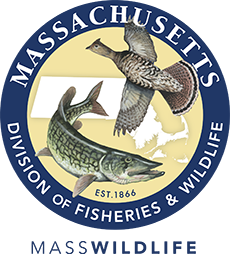- Division of Fisheries and Wildlife
- MassWildlife's Natural Heritage & Endangered Species Program
Media Contact
Media Contact, MassWildlife

MassWildlife officials recently confirmed that a bald eagle that died in March was the victim of second-generation anticoagulant rodenticide (SGAR) poisoning. While mortalities in bald eagles due to anticoagulant rodenticides have been documented in other states, this is the first confirmed case in Massachusetts. In mid-March, observers reported odd behavior of an adult female eagle at a nest located on the Charles River in Middlesex County. Unfortunately, within a day, the bird had died on its nest. MassWildlife officials retrieved the eagle and transported it to Tufts Wildlife Clinic at Cummings Veterinary Medical Center at Tufts University where a necropsy was performed. Toxicology testing of a liver sample was performed with the assistance of the Northeast Wildlife Disease Cooperative. Both the necropsy and toxicology test results confirmed that the cause of death was lethal levels of anticoagulant rodenticides.
Anticoagulant rodenticides are a type of rodent poison that kills by preventing blood from clotting normally, resulting in a fatal hemorrhage. Wildlife can be poisoned by anticoagulant rodenticides in two ways: 1) primary poisoning when an animal directly eats the bait and dies several days later, or 2) secondary poisoning when a predator or scavenger eats prey that has consumed the bait. Secondary poisoning has been documented in birds of prey like hawks and owls, as well as foxes, bobcats, and coyotes. While bald eagles primarily eat fish, they are opportunistic foragers that feed on a variety of animals and are known to scavenge or prey on small mammals.
Given the hunting range of eagles, it’s impossible to determine the exact source of this rodenticide poisoning. Analysis of liver tissue confirmed three different SGARs were ingested by the eagle. In the past 15 years, the US EPA has taken steps to impose restrictions on rodenticides (see table below). SGARs are believed to be most harmful to wildlife and now cannot be sold through general consumer outlets for the typical homeowner to use. SGARs can still be purchased online in commercial use quantities, and licensed pest professionals and agricultural users are able to use them. Other rodenticides, called first-generation anticoagulant rodenticides (FGARs) and non-anticoagulant rodenticides, are still approved for residential consumer use if enclosed within a bait station.
“The struggle to control mice and rats is usually viewed in terms of humans vs. rodents, but wildlife such as birds of prey are often not recognized as players in this battle,” said Dr. Maureen Murray, Director of Tufts Wildlife Clinic. "Many people are surprised to learn that the mouse poison they use in their basement can also kill the great horned owl hooting in the neighborhood.” Studies in other species of birds of prey conducted at Tufts Wildlife Clinic have shown widespread exposure to SGARs among these birds. MassWildife officials, in partnership with Tufts Wildlife Clinic, provide the following advice for homeowners with a rodent problem to minimize harm to wildlife:
- Rodent-proof your home. Before using a poison, remove or securely contain any potential food sources for rodents. Repair any exterior areas of your home to prevent rodents from coming inside.
- Arm yourself with information. Consider alternatives to poison, such as snap traps. Poisons should be used as a last resort. Be sure to check the active ingredients and opt for products that contain bromethalin, chlorophacinone, or diphacinone. Use poisons only in bait stations as per the label instructions and avoid any in pellet form.
- Ask your pest control company questions. Look for an integrated pest management company that uses multiple approaches to pest control instead of relying solely on poisons. You can request that the company avoid using SGAR products including brodifacoum, bromadiolone, difenacoum, or difethialone.
While the death of this individual bald eagle is disturbing, MassWildlife officials are encouraged to report that the overall population of bald eagles in Massachusetts continues to recover and grow in numbers and geographic distribution. In fact, the nest where the female bald eagle died in March may already have a new resident. According to observers, within a week of the female’s death, another adult female eagle was observed at the nest with the male adult. “The appearance of a new female in such a short period of time speaks to the state’s robust eagle population,” said Andrew Vitz, MassWildlife’s State Ornithologist. “Though it is late in the mating season, it is possible that this bird may lay eggs this spring. If not, pair bonding between the two birds will strengthen over the year and nesting will likely be attempted in the early spring of 2022.” Thanks to the efforts of MassWildlife and other conservation partners, there are currently over 80 pairs of bald eagles nesting in Massachusetts from the Cape to the Berkshires. Click here to learn more about bald eagle conservation in Massachusetts.
Summary of Rodenticides
|
Type of rodenticide |
Examples |
Use |
|---|---|---|
|
SGAR |
brodifacoum, difethialone, bromadiolone, difenacoum |
Prohibited for residential consumer purchase; available to licensed professionals and agricultural users |
|
FGAR |
chlorophacinone, diphacinone |
Approved for residential consumer use (must be enclosed within a bait station) |
|
Non-anticoagulant |
bromethalin |
Approved for residential consumer use (must be enclosed within a bait station) |
Image credit: Bald Eagle (Courtesy of James B. Condon, Jr)
Other resources
Please click here for a list of licensed Problem Animal Control agents.
Please see these articles about rodenticides and wildlife:
-
“How to Spoil an Owl’s Dinner” by Maureen Murray, DVM. Massachusetts Wildlife, No. 3, 2014.
-
“Understanding the Risks of Rodent Poisons to Birds of Prey” by Angela Nelson. TuftsNow, 2020.
-
“Keep Your Home Safe From Rodent Poisons” by Genevieve Rajewski. Tufts Magazine, 2015.

